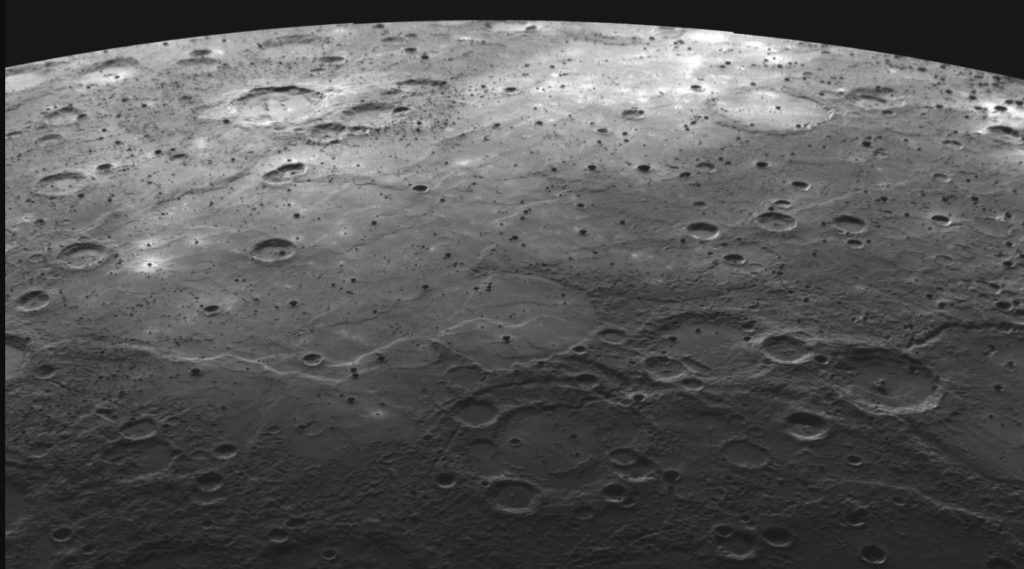
Images from Messenger show previously uncharted regions of the planet that have large craters with an internal smoothness similar to Earth’s own moon and that are thought to have been flooded by lava flows.
An international team of scientists has proved that Mercury, our solar system’ssmallest planet, has geomagnetic storms similar to those on Earth.
The research by scientists in the United States, Canada and China includes work by Hui Zhang, a space physics professor at the University of Alaska Fairbanks Geophysical Institute.
Their finding, a first, answers the question of whether other planets, including those outside our solar system, can have geomagnetic storms regardless of the size of their magnetosphere or whether they have an Earth-like ionosphere.
The research was published in two papers in February. Zhang is among the co-authors of each paper.
The first of those papers proves the planet has a ring current, a doughnut-shaped field of charged particles flowing laterally around the planet and excluding the poles. The second proves the existence of geomagnetic storms triggered by the ring current.
A geomagnetic storm is a major disturbance in a planet’s magnetosphere caused by the transfer of energy from the solar wind. Such storms in Earth’s magnetosphere produce the aurora and can disrupt radio communications.
The geomagnetic storms finding was published Feb. 18 in the journal Science China Technological Sciences. QiuGang Zong of the Institute of Space Physics and Applied Technology at Peking University and the Polar Research Institute of China is the author.
That paper built on a finding published one day earlier that verified through data observation earlier suggestions that Mercury has a ring current. Earth also has a ring current.
The ring current paper, published in Nature Communications, is authored by Jiutong Zhao, also of the Institute of Space Physics and Applied Technology at Peking University.
Seven of the 14 scientists involved worked on both papers.
“The processes are quite similar to here on Earth,’ Zhang said of Mercury’s magnetic storms. “The main differences are the size of the planet and Mercury has a weak magnetic field and virtually no atmosphere.”
Confirmation about geomagnetic storms on Mercury results from research made possible by a fortuitous coincidence: a series of coronal mass ejections from the sun on April 8-18, 2015, and the end of NASA’s Messenger space probe, which launched in 2004 and crashed into the planet’s surface on April 30, 2015, at the expected end of its mission.
A coronal mass ejection, or CME, is an ejected cloud of the sun’s plasma — a gas made of charged particles. That cloud includes the plasma’s embedded magnetic field.
The coronal mass ejection of April 14 proved to be the key for scientists. It compressed Mercury’s ring current on the sun-facing side and increased the current’s energy.
New analysis of data from Messenger, which had dropped closer to the planet, shows “the presence of a ring current intensification that is essential for triggering magnetic storms,” the second of the two papers reads.
“The sudden intensification of a ring current causes the main phase of a magnetic storm,” Zhang said.
But this doesn’t mean Mercury has auroral displays like those on Earth.
On Earth, the storms produce aurora displays when solar wind particles interact with the particles of the atmosphere. On Mercury, however, solar wind particles don’t encounter an atmosphere. Instead, they reach the surface unimpeded and may therefore be visible only through X-ray and gamma ray examination.
The results of the two papers show that magnetic storms are “potentially a common feature of magnetized planets,” the second of the papers reads.
“The results obtained from Messenger provide a further fascinating insight into Mercury’s place in the evolution of the solar system following the discovery of its intrinsic planetary magnetic field,” it concludes.
Other institutions involved in the research include the University of Alberta, Edmonton; University of Michigan and the Heliophysics Science Division at NASA’s Goddard Space Flight Center. https://uaf.edu/news/uaf-researcher-in-papers-that-prove-mercury-has-magnetic-storms.php








Recent Comments